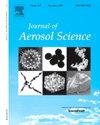A mechanistic analysis code for aerosol migration behavior associated with a large-scale bubble during a core disruptive accident
IF 2.9
3区 环境科学与生态学
Q2 ENGINEERING, CHEMICAL
引用次数: 0
Abstract
The potential release of radioactive materials is a crucial design consideration for advanced reactors, especially for minimizing environment impact during severe accidents. In this context, studying the release of radioactive materials from the sodium pool during a core disruptive accident (CDA)—the most severe accident in a sodium-cooled fast reactor—is of significant value. During a CDA, fission products can migrate as aerosol particles through the sodium pool to the cover gas region in a short time (approximately a few hundred milliseconds) along with a large-scale, multi-phase, multi-component bubble generated after the core recriticality. To address this issue, we developed a code to simulate the migration behavior of aerosols with the large-scale bubble within the sodium pool. The code is based on a one-dimensional two-phase multi-component CDA bubble model and integrates an aerosol migration model to explain the process of aerosol particle absorption by the coolant. Using analysis results of the core provided by the internationally recognized severe accident analysis program SIMMER as boundary input conditions, the code was used to implement a trial calculation of the in-vessel migration of the representative fission product cesium during a CDA in a prototype sodium-cooled fast reactor. In the case where cesium and sodium were immiscible, the overall computational results showed good consistency with the results from the SIMMER code, indicating the applicability of our code. Therefore, by accounting for the unique miscibility characteristics of cesium and sodium in the code, the final amount of cesium migration could be determined.
堆芯破坏事故中与大尺度气泡相关的气溶胶迁移行为的机制分析程序
放射性物质的潜在释放是先进反应堆设计的一个重要考虑因素,特别是在严重事故中尽量减少对环境的影响。在此背景下,研究钠冷快堆中最严重的堆芯破坏事故(CDA)中钠池中放射性物质的释放具有重要意义。在CDA过程中,裂变产物可以作为气溶胶粒子在短时间内(大约几百毫秒)通过钠池迁移到覆盖气体区,同时在堆芯临界后产生大规模的多相多组分气泡。为了解决这个问题,我们开发了一个代码来模拟钠池内气溶胶与大尺度气泡的迁移行为。该程序基于一维两相多组分CDA气泡模型,并集成了气溶胶迁移模型来解释气溶胶颗粒被冷却剂吸收的过程。利用国际公认的严重事故分析程序SIMMER提供的堆芯分析结果作为边界输入条件,利用该代码对原型钠冷快堆CDA过程中代表性裂变产物铯的容器内迁移进行了试算。在铯和钠不混相的情况下,总体计算结果与SIMMER程序的计算结果具有较好的一致性,表明了程序的适用性。因此,考虑到代码中铯和钠的独特混相特性,可以确定铯的最终迁移量。
本文章由计算机程序翻译,如有差异,请以英文原文为准。
求助全文
约1分钟内获得全文
求助全文
来源期刊

Journal of Aerosol Science
环境科学-工程:化工
CiteScore
8.80
自引率
8.90%
发文量
127
审稿时长
35 days
期刊介绍:
Founded in 1970, the Journal of Aerosol Science considers itself the prime vehicle for the publication of original work as well as reviews related to fundamental and applied aerosol research, as well as aerosol instrumentation. Its content is directed at scientists working in engineering disciplines, as well as physics, chemistry, and environmental sciences.
The editors welcome submissions of papers describing recent experimental, numerical, and theoretical research related to the following topics:
1. Fundamental Aerosol Science.
2. Applied Aerosol Science.
3. Instrumentation & Measurement Methods.
 求助内容:
求助内容: 应助结果提醒方式:
应助结果提醒方式:


